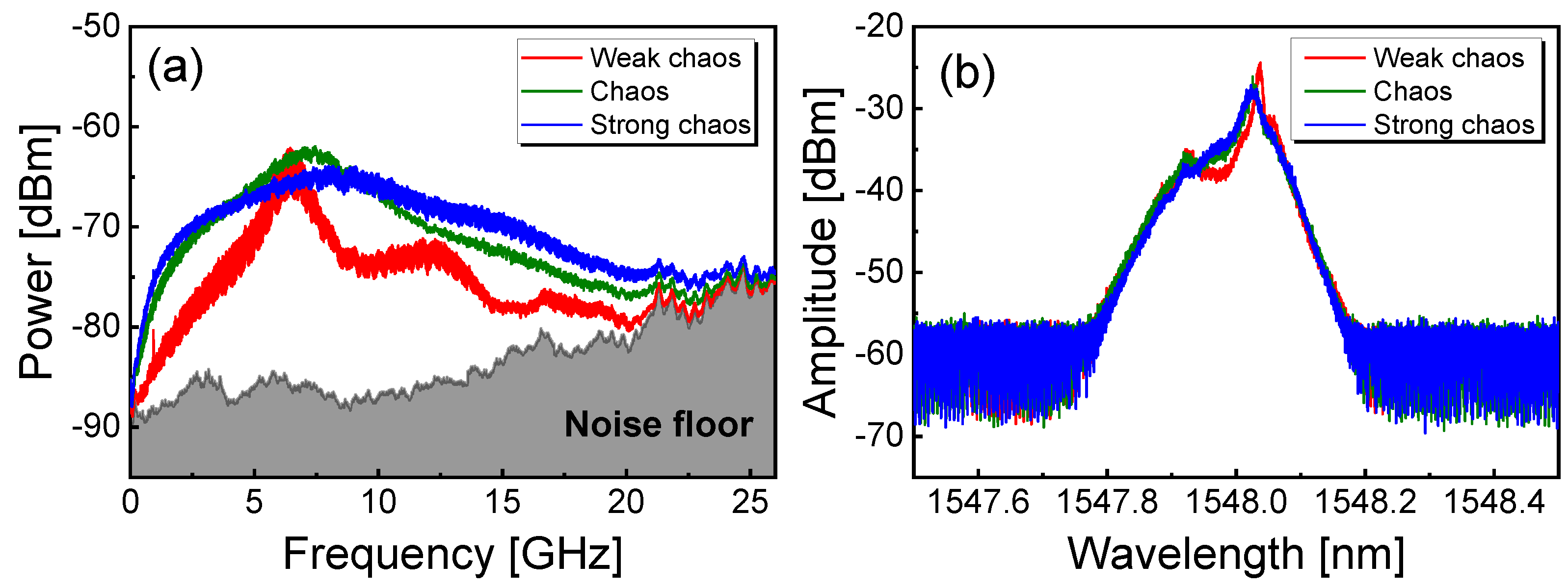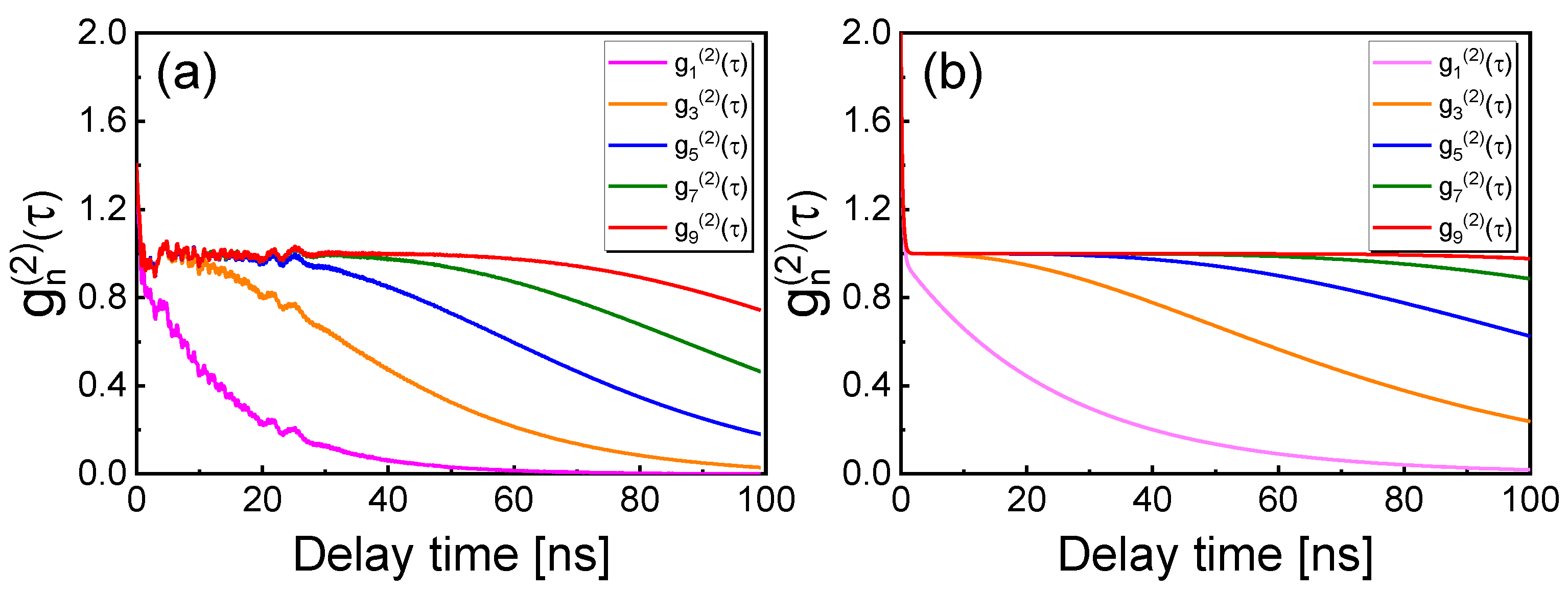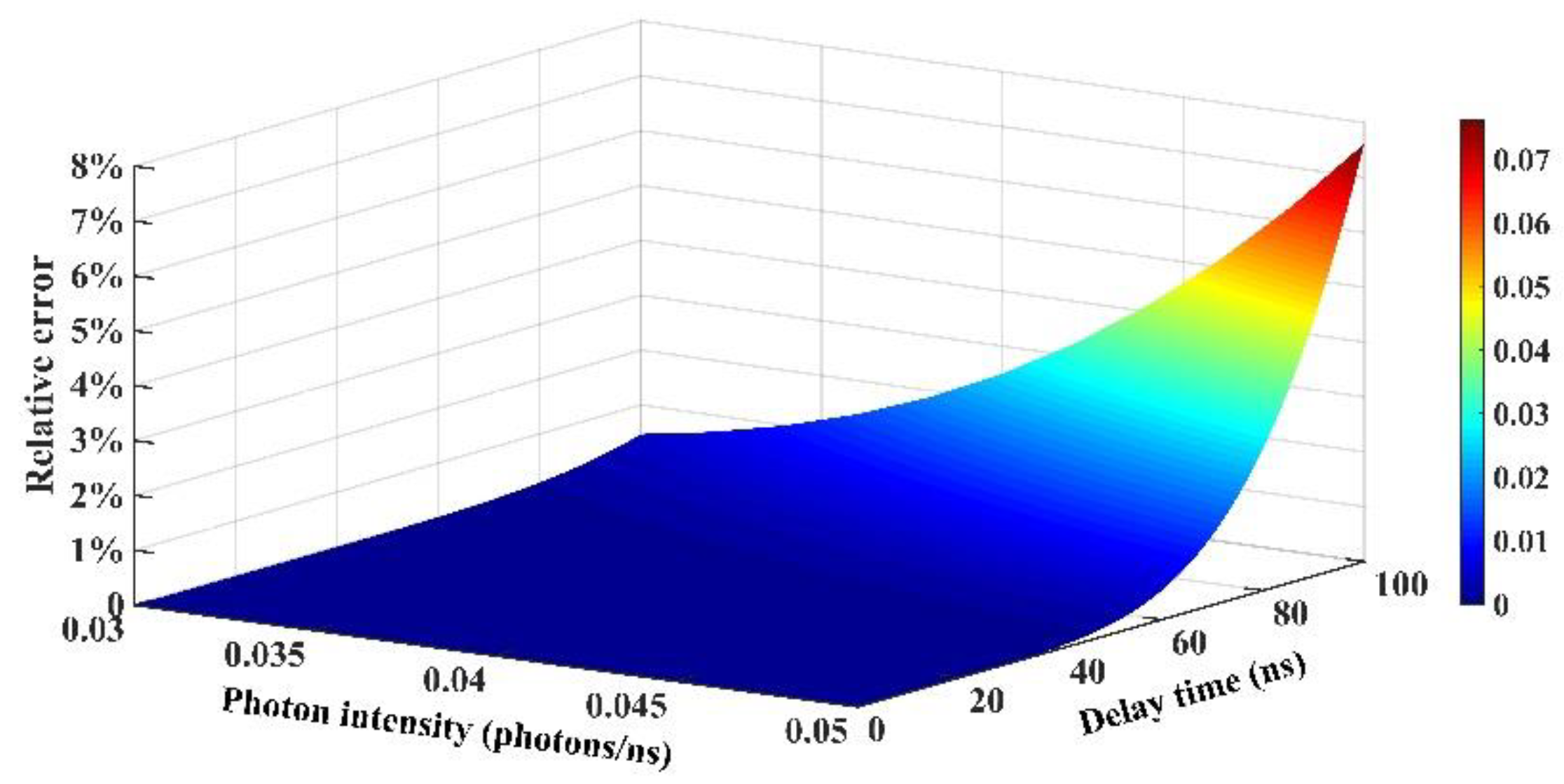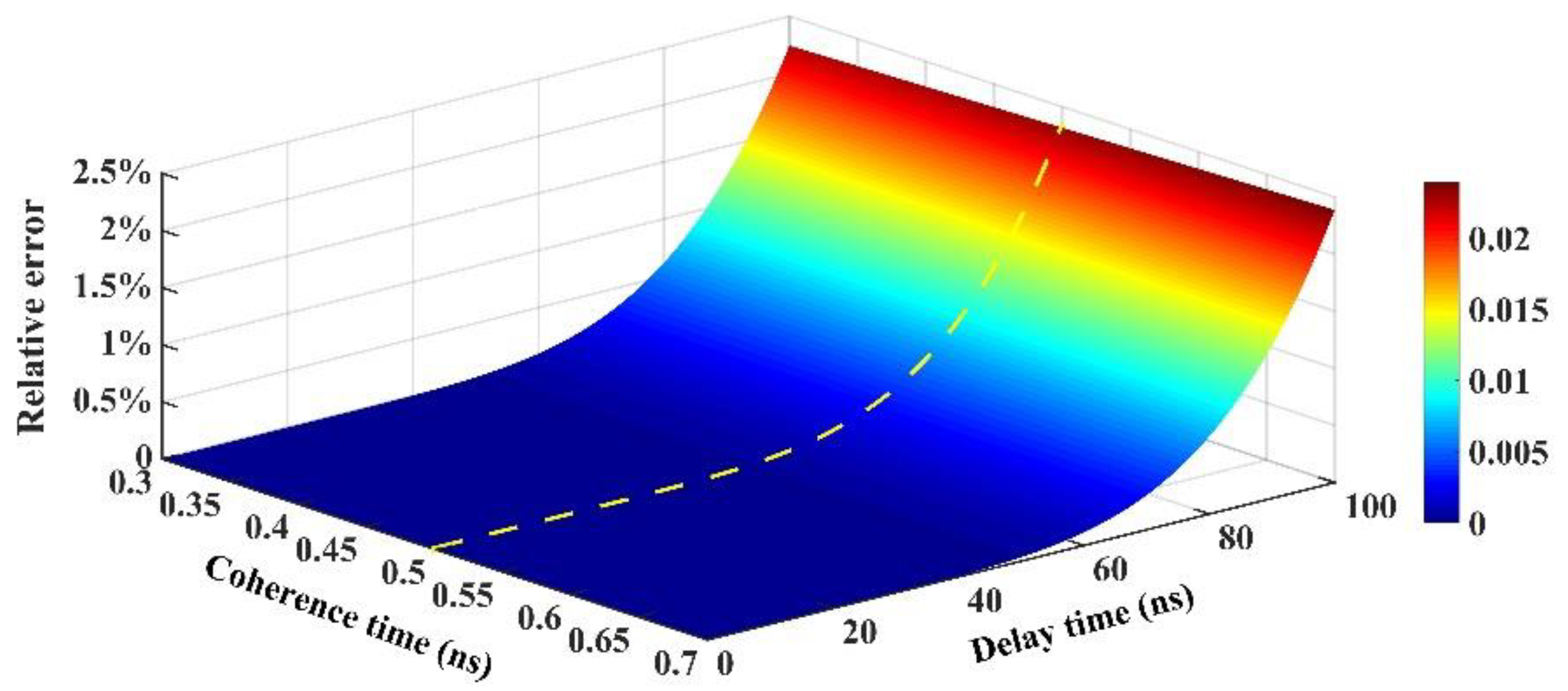Precise Photon Correlation Measurement of a Chaotic Laser
Abstract
Featured Application
Abstract
1. Introduction
2. High Order Correction of g(2)(τ)
3. Experiment Setup
4. Experimental Results
5. Influences of Detector Time Resolution and High Order Omitted Terms
6. Relative Error of (τ) With Mean Photon Intensity and Coherence Time of the Chaotic Laser
7. Conclusions
Author Contributions
Funding
Acknowledgments
Conflicts of Interest
References
- Soriano, M.C.; García-Ojalvo, J.; Mirasso, C.R.; Fischer, I. Complex photonics: Dynamics and applications of delay-coupled semiconductors lasers. Rev. Mod. Phys. 2013, 85, 421–470. [Google Scholar] [CrossRef]
- Sciamanna, M.; Shore, K.A. Physics and applications of laser diode chaos. Nat. Photonics. 2015, 9, 151–162. [Google Scholar] [CrossRef]
- VanWiggeren, G.D.; Roy, R. Communication with chaotic lasers. Science 1998, 279, 1198–1200. [Google Scholar] [CrossRef] [PubMed]
- Argyris, A.; Syvridis, D.; Larger, L.; Annovazzi-Lodi, V.; Colet, P.; Fischer, I.; García-Ojalvo, J.; Mirasso, C.R.; Pesquera, L.; Shore, K.A. Chaos-based communications at high bit rates using commercial fibre-optic links. Nature 2005, 438, 343–346. [Google Scholar] [CrossRef] [PubMed]
- Hong, Y.; Lee, M.W.; Paul, J.; Spencer, P.S.; Shore, K.A. Enhanced chaos synchronization in unidirectionally coupled vertical-cavity surface-emitting semiconductor lasers with polarization-preserved injection. Opt. Lett. 2008, 33, 587–589. [Google Scholar] [CrossRef] [PubMed]
- Wu, J.G.; Wu, Z.M.; Xia, G.Q.; Deng, T.; Lin, X.D.; Tang, X.; Feng, G.Y. Isochronous synchronization between chaotic semiconductor lasers over 40-km fiber links. IEEE Photon. Technol. Lett. 2011, 23, 1854–1856. [Google Scholar] [CrossRef]
- Lavrov, R.; Jacquot, M.; Larger, L. Nonlocal nonlinear electro-optic phase dynamics demonstrating 10 Gb/s chaos communications. IEEE J. Quantum Electron. 2010, 46, 1430–1435. [Google Scholar] [CrossRef]
- Yoshimura, K.; Davis, J.P.; Harayama, T.; Okumura, H.; Morikatsu, S.; Aida, H.; Uchida, A. Secure key distribution using correlated randomness in lasers driven by common random light. Phys. Rev. Lett. 2012, 108, 070602. [Google Scholar] [CrossRef]
- Uchida, A.; Amano, K.; Inoue, M.; Hirano, K.; Naito, S.; Someya, H.; Oowada, I.; Kurashige, T.; Shiki, M.; Yoshimori, S.; et al. Fast physical random bit generation with chaotic semiconductor lasers. Nat. Photonics 2008, 2, 728–732. [Google Scholar] [CrossRef]
- Reidler, I.; Aviad, Y.; Rosenbluh, M.; Kanter, I. Ultrahigh-speed random number generation based on a chaotic semiconductor laser. Phys. Rev. Lett. 2009, 103, 024102. [Google Scholar] [CrossRef]
- Kanter, I.; Aviad, Y.; Reidler, I.; Cohen, E.; Rosenbluh, M. An optical ultrafast random bit generator. Nat. Photonics 2010, 4, 58–61. [Google Scholar] [CrossRef]
- Wang, A.B.; Li, P.; Zhang, J.G.; Zhang, J.Z.; Li, L.; Wang, Y.C. 4.5 Gbps high-speed real-time physical random bit generator. Opt. Express 2013, 21, 20452–20462. [Google Scholar] [CrossRef] [PubMed]
- Brunner, D.; Soriano, M.C.; Mirasso, C.R.; Fischer, I. Parallel photonic information processing at gigabyte per second data rates using transient states. Nat. Commun. 2013, 4, 1364. [Google Scholar] [CrossRef] [PubMed]
- Lin, F.Y.; Liu, J.M. Chaotic radar using nonlinear laser dynamics. IEEE J. Quantum Electron. 2004, 40, 815–820. [Google Scholar] [CrossRef]
- Wang, Y.C.; Wang, B.J.; Wang, A.B. Chaotic correlation optical time domain reflectometer utilizing laser diode. IEEE Photon. Technol. Lett. 2008, 20, 1636–1638. [Google Scholar] [CrossRef]
- Xia, L.; Huang, D.; Xu, J.; Liu, D. Simultaneous and precise fault locating in WDM-PON by the generation of optical wideband chaos. Opt. Lett. 2013, 38, 3762–3764. [Google Scholar] [CrossRef]
- Heil, T.; Fischer, I.; Elsässer, W.; Mulet, J.; Mirasso, C.R. Statistical properties of low-frequency fluctuations during single-mode operation in distributed-feedback lasers: experiments and modeling. Opt. Lett. 1999, 24, 1275–1277. [Google Scholar] [CrossRef]
- Sukow, D.W.; Heil, T.; Fischer, I.; Gavrielides, A.; Hohl-AbiChedia, A.; Elsässer, W. Picosecond intensity statistics of semiconductor lasers operating in the low-frequency fluctuation regime. Phys. Rev. A. 1999, 60, 667–673. [Google Scholar] [CrossRef]
- Li, N.; Kim, B.; Locquet, A.; Choi, D.; Pan, W.; Citrin, D.S. Statistics of the optical intensity of a chaotic external-cavity DFB laser. Opt. Lett. 2014, 39, 5949–5952. [Google Scholar] [CrossRef]
- Heiligenthal, S.; Dahms, T.; Yanchuk, S.; Jüngling, T.; Flunkert, V.; Kanter, I.; Schöll, E.; Kinzel, W. Strong and Weak Chaos in Nonlinear Networks with Time-Delayed Couplings. Phys. Rev. Lett. 2011, 107, 234102. [Google Scholar] [CrossRef]
- Porte, X.; Soriano, M.C.; Fischer, I. Similarity properties in the dynamics of delayed-feedback semiconductor lasers. Phys. Rev. A. 2014, 89, 023822. [Google Scholar] [CrossRef]
- Oliver, N.; Soriano, M.C.; Sukow, D.W.; Fischer, I. Dynamics of a semiconductor laser with polarization-rotated feedback and its utilization for random bit generation. Opt. Lett. 2011, 36, 4632–4634. [Google Scholar] [CrossRef] [PubMed]
- Albert, F.; Hopfmann, C.; Reitzenstein, S.; Schneider, C.; Höfling, S.; Worschech, L.; Kamp, M.; Kinzel, W.; Forchel, A.; Kanter, I. Observing chaos for quantum-dot microlasers with external feedback. Nat. Commun. 2011, 2, 366. [Google Scholar] [CrossRef] [PubMed]
- Guo, Y.Q.; Peng, C.S.; Ji, Y.L.; Li, P.; Guo, Y.Y; Guo, X.M. Photon statistics and bunching of a chaotic semiconductor laser. Opt. Express 2018, 26, 5991–6000. [Google Scholar] [CrossRef]
- Hanbury Brown, R.; Twiss, R.Q. Correlation between photons in two coherent beams of light. Nature 1956, 177, 27–29. [Google Scholar] [CrossRef]
- Glauber, R.J. Photon Correlations. Phys. Rev. Lett. 1963, 10, 84–86. [Google Scholar] [CrossRef]
- Glauber, R.J. The Quantum Theory of Optical Coherence. Phys. Rev. 1963, 130, 2529–2539. [Google Scholar] [CrossRef]
- Glauber, R.J. Coherent and Incoherent States of the Radiation Field. Phys. Rev. 1963, 131, 2766–2788. [Google Scholar] [CrossRef]
- Arecchi, F.T. Measurement of the statistical distribution of Gaussian and laser sources. Phys. Rev. Lett. 1965, 15, 912–916. [Google Scholar] [CrossRef]
- Kimble, H.; Dagenais, J.M.; Mandel, L. Photon antibunching in resonance fluorescence. Phys. Rev. Lett. 1977, 39, 691–695. [Google Scholar] [CrossRef]
- Oberreiter, L.; Gerhardt, I. Light on a beam splitter: More randomness with single photons. Laser Photonics Rev. 2016, 10, 108–115. [Google Scholar] [CrossRef]
- Sun, F.-W.; Shen, A.; Dong, Y.; Chen, X.D.; Guo, G.C. Bunching effect and quantum statistics of partially indistinguishable photons. Phys. Rev. A. 2017, 96, 023823. [Google Scholar] [CrossRef]
- Schultheiss, V.H.; Batz, S.; Peschel, U. Hanbury Brown and Twiss measurements in curved space. Nat. Photonics 2016, 10, 106–110. [Google Scholar] [CrossRef]
- Smith, T.A.; Shih, Y. Turbulence-Free Double-slit Interferometer. Phys. Rev. Lett. 2018, 120, 063606. [Google Scholar] [CrossRef]
- Chen, X.H.; Agafonov, I.N.; Luo, K.H.; Liu, Q.; Xian, R.; Chekhova, M.V.; Wu, L.A. High-visibility, high-order lensless ghost imaging with thermal light. Opt. Lett. 2010, 35, 1166–1168. [Google Scholar] [CrossRef]
- Zhou, Y.; Simon, J.; Liu, J.; Shih, Y. Third-order correlation function and ghost imaging of chaotic thermal light in the photon counting regime. Phys. Rev. A. 2010, 81, 043831. [Google Scholar] [CrossRef]
- Ryczkowski, P.; Barbier, M.; Friberg, A.T.; Dudley, J.M.; Genty, G. Ghost imaging in the time domain. Nat. Photonics 2016, 10, 167–170. [Google Scholar] [CrossRef]
- Magaña-Loaiza, O.S.; Mirhosseini, M.; Cross, R.M.; Hashemi Rafsanjani, S.M.; Boyd, R.W. Hanbury Brown and Twiss interferometry with twisted light. Sci. Adv. 2016, 2, e1501143. [Google Scholar] [CrossRef]
- Guo, Y.Q.; Li, G.; Zhang, Y.F.; Zhang, P.F.; Wang, J.M.; Zhang, T.C. Efficient fluorescence detection of a single neutral atom with low background in a microscopic optical dipole trap. Sci. China: Phys. Mech. Astron. 2012, 55, 1523–1528. [Google Scholar] [CrossRef]
- Loudon, R. Quantum degrees of first and second-order coherence. In The Quantum Theory of Light, 3rd ed.; Oxford University Press: New York, NY, USA, 2000; pp. 176–178. [Google Scholar]
- Boitier, F.; Godard, A.; Rosencher, E.; Fabre, C. Measuring photon bunching at ultrashort timescale by two-photon absorption in semiconductors. Nat. Phys. 2009, 5, 267–270. [Google Scholar] [CrossRef]
- Nevet, A.; Hayat, A.; Ginzburg, P.; Orenstei, M. Indistinguishable photon pairs from independent true chaotic sources. Phys. Rev. Lett. 2011, 107, 253601. [Google Scholar] [CrossRef] [PubMed]
- Bai, B.; Liu, J.; Zhou, Y.; Zheng, H.; Chen, H.; Zhang, S.; He, Y.; Li, F.; Xu, Z. Photon superbunching of classical light in the Hanbury Brown–Twiss interferometer. J. Opt. Soc. Am. B 2017, 34, 2081–2088. [Google Scholar] [CrossRef]
- Huang, C.H.; Wen, Y.H.; Liu, Y.W. Measuring the second order correlation function and the coherence time using random phase modulation. Opt. Express 2016, 24, 4278–4288. [Google Scholar] [CrossRef] [PubMed]
- Beck, M. Comparing measurements of g(2)(0) performed with different coincidence detection techniques. J. Opt. Soc. Am. B 2007, 24, 2972–2978. [Google Scholar] [CrossRef]
- Lin, F.Y.; Liu, J.M. Nonlinear dynamical characteristics of an optically injected semiconductor laser subject to optoelectronic feedback. Optics Commun. 2003, 221, 173–180. [Google Scholar] [CrossRef]
- Wang, Y.; Kong, L.; Wang, A.; Fan, L. Coherence length tunable semiconductor laser with optical feedback. Appl. Optics 2009, 48, 969–973. [Google Scholar] [CrossRef]







© 2019 by the authors. Licensee MDPI, Basel, Switzerland. This article is an open access article distributed under the terms and conditions of the Creative Commons Attribution (CC BY) license (http://creativecommons.org/licenses/by/4.0/).
Share and Cite
Guo, X.; Cheng, C.; Liu, T.; Fang, X.; Guo, Y. Precise Photon Correlation Measurement of a Chaotic Laser. Appl. Sci. 2019, 9, 4907. https://doi.org/10.3390/app9224907
Guo X, Cheng C, Liu T, Fang X, Guo Y. Precise Photon Correlation Measurement of a Chaotic Laser. Applied Sciences. 2019; 9(22):4907. https://doi.org/10.3390/app9224907
Chicago/Turabian StyleGuo, Xiaomin, Chen Cheng, Tong Liu, Xin Fang, and Yanqiang Guo. 2019. "Precise Photon Correlation Measurement of a Chaotic Laser" Applied Sciences 9, no. 22: 4907. https://doi.org/10.3390/app9224907
APA StyleGuo, X., Cheng, C., Liu, T., Fang, X., & Guo, Y. (2019). Precise Photon Correlation Measurement of a Chaotic Laser. Applied Sciences, 9(22), 4907. https://doi.org/10.3390/app9224907






